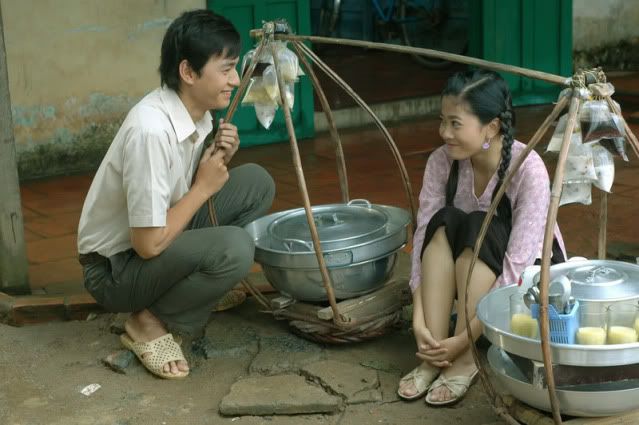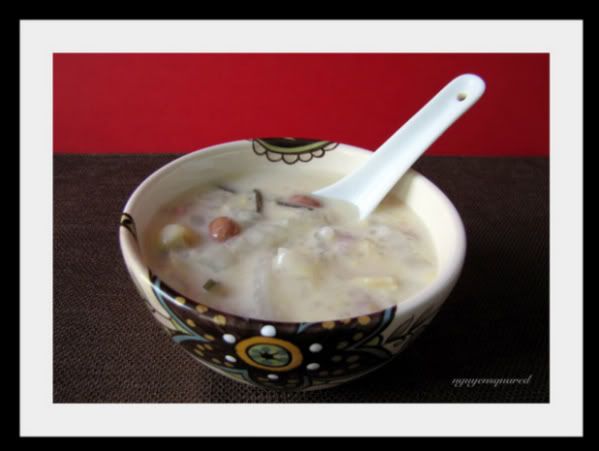I thought I should have a post on something Vietnamese before I'm accused of being an impostor ;) So what better than a Vietnamese dessert, right?
In general, chè, translated to English as "sweet soup", is a term used to describe many desserts in Vietnam. Don't let the word "soup" fool you, many of these desserts have the same texture as, I should say, chowder. When I was young, my aunt used to take me with her when she went to the market. Sometimes I would be rewarded with a "bag" of chè from one of the mobile "stores", like in the photo below:
(This photo is taken from a Viet film. In real life, people who sell chè are often old(er) women and not young pretty girls like it is portrayed here.) I often couldn't wait till I get home before devouring it. I would bite a little hole off the bag and squeeze the chè out ;) while sitting on the back of my aunt's motor scooter. The drive home probably lasted about 5' but I always finished my chè before I even got home.
Chè is just as diverse as savory dishes as one travels across the country. Most chè in Saigon, for example, are served with shaved ice due to the warm weather, while many types of chè in Dalat, my hometown, are served warm/hot. To be honest, my being Vietnamese certainly does not imply my being well-versed in Vietnamese cuisine, especially northern cuisine. So I'm not even going to try telling you about chè in the north. But what I'm going to do in this post is giving you a recipe of a southern chè. I have to say that this was produced from memory and I tried my very best to keep track of the amounts of each ingredient that goes into this dessert.
I did a google search before attempting this dish as it has been a while since I last had it and wasn't quite sure what goes into it. What I found was that there are quite a number of posts in English that say this is "Vietnamese bo bo cha cha". Well, bo bo cha cha is a Singaporean/nonya dessert that is more a cousin of chè bà ba (another Viet dessert) than chè thưng. For example, chè thưng should not contain sweet potato and yam/tapioca. Or maybe I have been fooled all my life by the chè thưng I eat in my hometown. Oh well! Anyway, without any further ado, here it is:
INGREDIENTS:
Overnight soaking, active time: ~1h, total time:~3h
Make about 6 servings
1/2 cup peanuts
1/3 cup dried lotus seeds
1/3 cup split mung beans
1/4 cup tapioca pearls
1/3 bag tapioca strips
2 cups water
1/2 cup + 1Tsp sugar
Shredded kelp (either fresh or dried)
6oz (or more) coconut cream
1/2 bunch washed pandan leaves (if not available, vanilla extract maybe used)
METHOD:
Soak the peanuts in water overnight, then boil until soft. (This will take a while, be patient). Strain and put aside.
Soak lotus seeds and mung beans in water for about an hour. Make sure you remove the stems inside the lotus seeds, otherwise it will be bitter. Cook these separately till they are soft. Strain and put the lotus seeds aside. Be careful with the mung beans as they burn easily, it's best to cook them on low heat. Once the mung beans boil, remove bubbles on top. Once they are done, remove most of the water.
Soak the tapioca strips for about 10min and follow the instruction here to separately prepare the tapioca pearls and strips. The strips should be allowed to boil for a few more minutes before heat is turned off. Strain and set aside.
If using fresh kelp, bring some water to a strong boil, put the kelp in and let it cook for ~2min, remove from heat, wash under cold water and place in an iced bath to stop the cooking. Otherwise, you will get very mushy kelp. Cut into 2in strips. If using dried kelp, soak it in warm water, then wash under cold water and then cut into strips.
While waiting for the mung beans to cook, put water, sugar and pandan leaves in a 3-4 qt pot on low heat and bring to a soft boil. Stir occasionally to make sure the sugar is dissolved. Once sugar is dissolved, let the mixture cook for another 20min or so to allow the syrup to absorb the pandan flavor. Once done, remove the pandan leaves. Add the peanuts, lotus seeds, and mung beans into the mixture, stir. Add the coconut cream, mix well. Make sure the mixture is not too thick, or you will have to add some more water and sugar if necessary. Once the coconut has blended in completely, add the tapioca pearls and strips, and the kelp. Let cook for another minute or so.
This dessert can be served warm on a cold day, or chilled or with shaved ice on a warm day. Bon appetit!


Can anyone tell me how many calories per serving or the nutritional information
ReplyDeleteI don't know but I am guessing that there are fewer calories than in, say, a slice of cheese cake.
Delete